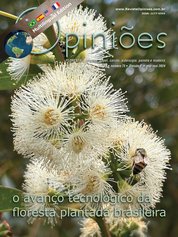Bianca Cristina Costa Gea e Nilmara Pereira Caires
Pesquisadora de Entomologia e Pesquisadora de Fitopatologia, da Suzano, respectivamente
OpCP75
Manejo integrado de pragas e doenças
 O sucesso do setor florestal brasileiro é fruto de décadas de avanços no melhoramento e manejo das florestas plantadas. Dentre as técnicas que constantemente evoluem, destacam-se o manejo integrado de Pragas e Doenças (P&D). A entrada e aumento da incidência desses organismos em áreas cultivadas com eucalipto no Brasil nos últimos anos, aliada à expansão do setor florestal para regiões que favorecem a incidência de algumas doenças e espécies de insetos-praga, impulsionou a estruturação do Manejo Integrado de Pragas e Doenças (MIPD), que utiliza diferentes formas de detecção, monitoramento e controle (biológico, químico, genético, cultural, entre outros), de maneira a promover o uso racional dos produtos químicos visando proteger as plantas mitigando os impactos à sociedade e ambiente.
O sucesso do setor florestal brasileiro é fruto de décadas de avanços no melhoramento e manejo das florestas plantadas. Dentre as técnicas que constantemente evoluem, destacam-se o manejo integrado de Pragas e Doenças (P&D). A entrada e aumento da incidência desses organismos em áreas cultivadas com eucalipto no Brasil nos últimos anos, aliada à expansão do setor florestal para regiões que favorecem a incidência de algumas doenças e espécies de insetos-praga, impulsionou a estruturação do Manejo Integrado de Pragas e Doenças (MIPD), que utiliza diferentes formas de detecção, monitoramento e controle (biológico, químico, genético, cultural, entre outros), de maneira a promover o uso racional dos produtos químicos visando proteger as plantas mitigando os impactos à sociedade e ambiente.
Um dos três pilares do MIPD é o monitoramento, que quantifica a incidência de P&D e a severidade na planta, através da adoção de diferentes estratégias, mediante a biologia e ecologia de cada organismo. Dessa forma passa a ser possível não apenas a detecção precoce e a obtenção de informações a respeito da distribuição geográfica dos insetos e das doenças, como também possibilita avaliar a densidade populacional e a efetividade de controle adotado. A importância de manter um programa sólido de monitoramento de pragas e doenças nas empresas torna-se clara quando se pensa na proteção das florestas, uso racional dos insumos e recursos.
A fim de minimizar as perdas causadas por esses organismos, a Suzano tem evoluído nas estratégias de manejo, a exemplo da implementação da Rede de Análise de Pragas, Inimigos Naturais e Doenças (RAPID). Implementada desde 2017, a rede consiste na instalação de armadilhas amarelas em talhões, viveiros e fábricas a fim de garantir a detecção precoce de pragas e dos seus inimigos naturais (INs). Como premissas, têm-se a coleta mensal das armadilhas, assim como a sua avaliação quantificando cada inseto coletado (pragas ou IN).
Os dados são processados e mensalmente disponibilizados internamente às partes interessadas. De acordo com o nível populacional de cada praga/inimigo natural, passa a ser possível a tomada de decisão, que pode variar desde o direcionamento de equipes para a monitoramento in loco ou liberação de INs.
O monitoramento de formigas cortadeiras, principal praga do setor, que mesmo em baixa ocorrência, leva à desfolha e consequentemente causa redução de produtividade, é sem dúvida um case de sucesso do setor florestal brasileiro para conviver com a praga. Realizado semestralmente, possui como parâmetros de avaliação a quantidade e o tamanho dos formigueiros que combinados a outros parâmetros geram índices de recomendação de não controle, remonitoramento, controle de borda ou controle em área total, permitindo usar racionalmente o formicida, pois já tivemos casos que em 65% da área amostrada, não houve necessidade da equipe de controle se deslocar até o talhão.
O monitoramento constante de P&D em viveiros clonais é de fundamental importância. A principal doença do eucalipto da atualidade, a murcha bacteriana, possui como agente causal a bactéria Ralstonia solanacearum, é veiculada ao campo por meio de mudas contaminadas. Na Suzano, é realizada anualmente a campanha de certificação sanitária de viveiros próprios e de terceiros, através de um censo em todas as calhas. Nesta campanha, as amostras são coletadas e submetidas à análise molecular para detecção de ralstonia, os resultados são discutidos com a área operacional e as calhas que exibem resultados positivos recebem a recomendação para reforma.
Comparado à agricultura, o setor florestal utiliza uma quantidade inferior de defensivos químicos para controle de doenças. Isso se deve ao sucesso na utilização do controle genético por meio da resistência de plantas. Um sólido programa de Melhoramento Genético, utiliza-se da fenotipagem de seus principais materiais para conhecer e mitigar os riscos de clones suscetíveis, excluindo-os do programa de plantio, se necessário. Por meio do programa chamado Fenomics, nos últimos 20 anos mais de 6.500 materiais genéticos foram fenotipados em condições controladas ou de campo na Suzano.
Se o controle genético é a estrela para o manejo de doenças, quando falamos em pragas, o controle biológico é o destaque, com cinco laboratórios com estrutura dedicada à produção de seis espécies de INs, contemplando as principais pragas do eucalipto. Apenas em 2023, mais de 285 milhões de INs foram liberados em 370 mil ha nas áreas da Suzano, um incremento de 37% em relação ao ano anterior. Além disso, o controle de lagartas desfolhadoras é 100% biológico, com uso de parasitoides e microrganismos. O controle químico é realizado apenas quando a população de determinada praga atinge o nível de surto, buscando-se constantemente a adoção de produtos seletivos aos INs, a fim de reduzir o nível populacional apenas da praga.
Embora tenhamos avançado muito nos últimos anos, o problema de P&D é dinâmico, exigindo monitoramento constante, a fim de mapear os problemas com antecedência. Recentemente duas novas lagartas desfolhadoras do eucalipto foram detectadas no Mato Grosso do Sul (Iridopsis panopla e Elasmopalpus lignoselus) e outras pragas como grilo, já ocorrem em diversos estados, indicando que a proteção das nossas florestas exige um cuidado constante. Diversas tecnologias estão em fase de desenvolvimento, com resultados promissores. A adoção dessas tecnologias, de forma equilibrada, é a base para a solidez de um programa de MIPD, mantendo a harmonia do ecossistema.




